|
||||||||||||||||||||||
![Home - Air Power Australia Website [Click for more ...]](APA/APA-Title-Main.png) |
||||||||||||||||||||||
![Sukhoi PAK-FA and Flanker Index Page [Click for more ...]](APA/flanker.png) |
![F-35 Joint Strike Fighter Index Page [Click for more ...]](APA/jsf.png) |
![Weapons Technology Index Page [Click for more ...]](APA/weps.png) |
![News and Media Related Material Index Page [Click for more ...]](APA/media.png) |
|||||||||||||||||||
![Surface to Air Missile Systems / Integrated Air Defence Systems Index Page [Click for more ...]](APA/sams-iads.png) |
![Ballistic Missiles and Missile Defence Page [Click for more ...]](APA/msls-bmd.png) |
![Air Power and National Military Strategy Index Page [Click for more ...]](APA/strategy.png) |
![Military Aviation Historical Topics Index Page [Click for more ...]](APA/history.png)
|
![Intelligence, Surveillance and Reconnaissance and Network Centric Warfare Index Page [Click for more ...]](APA/isr-ncw.png) |
![Information Warfare / Operations and Electronic Warfare Index Page [Click for more ...]](APA/iw.png) |
![Systems and Basic Technology Index Page [Click for more ...]](APA/technology.png) |
![Related Links Index Page [Click for more ...]](APA/links.png) |
|||||||||||||||
![Homepage of Australia's First Online Journal Covering Air Power Issues (ISSN 1832-2433) [Click for more ...]](APA/apa-analyses.png) |
||||||||||||||||||||||
| Last Updated: Mon Jan 27 11:18:09 UTC 2014 | ||||||||||||||||||||||
|
||||||||||||||||||||||
|
||||||||||||||||||||||
![Home - Air Power Australia Website [Click for more ...]](APA/APA-Title-Main.png) |
||||||||||||||||||||||
![Sukhoi PAK-FA and Flanker Index Page [Click for more ...]](APA/flanker.png) |
![F-35 Joint Strike Fighter Index Page [Click for more ...]](APA/jsf.png) |
![Weapons Technology Index Page [Click for more ...]](APA/weps.png) |
![News and Media Related Material Index Page [Click for more ...]](APA/media.png) |
|||||||||||||||||||
![Surface to Air Missile Systems / Integrated Air Defence Systems Index Page [Click for more ...]](APA/sams-iads.png) |
![Ballistic Missiles and Missile Defence Page [Click for more ...]](APA/msls-bmd.png) |
![Air Power and National Military Strategy Index Page [Click for more ...]](APA/strategy.png) |
![Military Aviation Historical Topics Index Page [Click for more ...]](APA/history.png)
|
![Intelligence, Surveillance and Reconnaissance and Network Centric Warfare Index Page [Click for more ...]](APA/isr-ncw.png) |
![Information Warfare / Operations and Electronic Warfare Index Page [Click for more ...]](APA/iw.png) |
![Systems and Basic Technology Index Page [Click for more ...]](APA/technology.png) |
![Related Links Index Page [Click for more ...]](APA/links.png) |
|||||||||||||||
![Homepage of Australia's First Online Journal Covering Air Power Issues (ISSN 1832-2433) [Click for more ...]](APA/apa-analyses.png) |
||||||||||||||||||||||
| Last Updated: Mon Jan 27 11:18:09 UTC 2014 | ||||||||||||||||||||||
|
||||||||||||||||||||||
| APA Editor Flying Experience |
||||
Carlo Kopp, BE(Hons), MSc, PhD, AFAIAA, SMIEEE, PEng 9th April 2012 Updated July, 2012 Text ┐ 1994 - 2012 Carlo Kopp Images ┐Copyright 1987 - 2012 Carlo Kopp |
||||
|
Dr Kopp holds a PPL but is not current at this time. Most of his command time is on the 8KCAB, a large proportion of that is aerobatic time. He holds the following ratings and endorsements:
In addition, he has flown a range of
military aircraft on various demonstration sorties since 1992, as well
as a number of military and civilian simulators.
|
||||
|
First Person Observations
|
||||
Military Types |
||||
Boeing F/A-18F Super Hornet (Sortie Avalon 2001, 17th February)Dual control demonstration
flight. A 1.1 hr sortie involving supersonic manoeuvre, high alpha
manoeuvring, touch and go landings and avionics and air intercept radar
demonstration. A delightful aircraft to fly with exceptional high alpha
handling. Detailed reports to be published in upcoming issues of
Australian Aviation and Air Power International [Pilot report]. |
||||
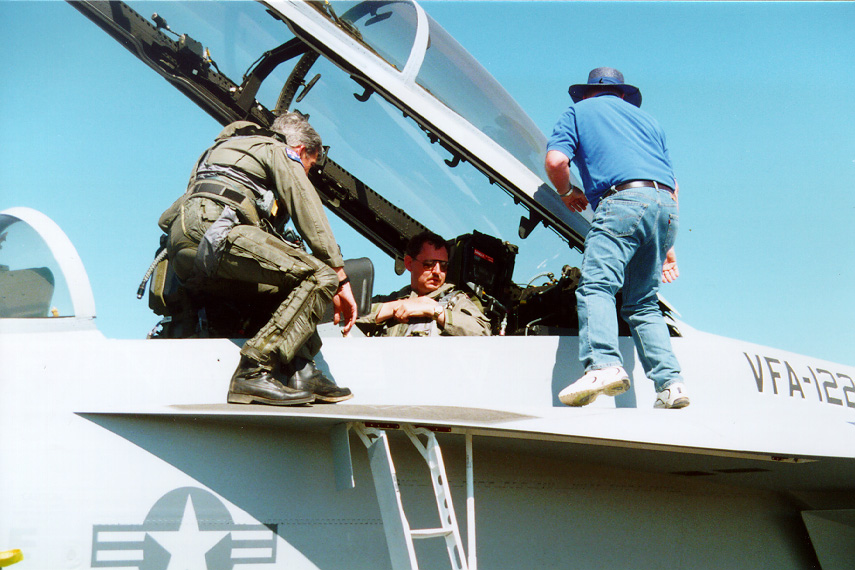 |
||||
 |
||||
Boeing AH-64D Apache Longbow (Sortie Avalon 1999, February)Gunner/Copilot
station
demonstration
flight.
A
45 minute sortie involving NOE OGE
hover from standoff location. A great opportunity to play with the
Longbow FCR and TADS, tracking and "engaging" highway traffic and
parked
aircraft using the MMWI Hellfire missiles. Detailed reports were
published in issues of Australian Aviation and Air Power International
[Read the report].(Photos:
Peter Harding). |
||||
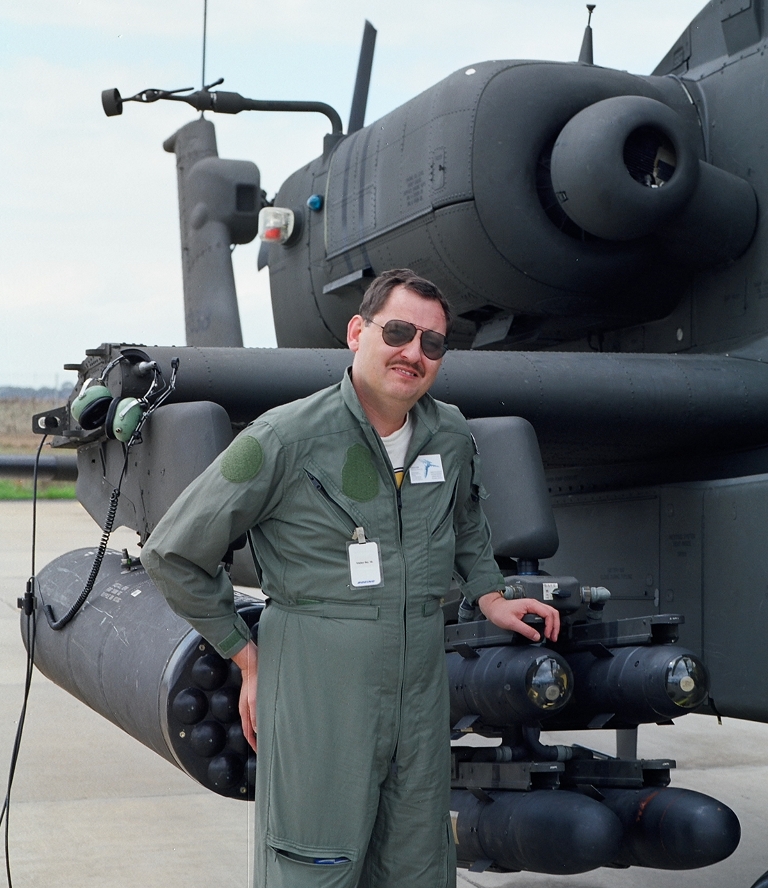 |
||||
 |
||||
|
||||
  |
||||
GD F-111C / Pave Tack Simulator (RAAF Amberley - 1995, 1998) Handling familiarisation of aircraft with a range of sweep settings and airspeeds (360 degree rolls, windup turns, pitch couples), high speed supersonic flight, recovery of compressor stalls and toss bombing with low level entry from TFR, including sliceback escape manoeuvre. Operation of APQ-165 attack radar and AVQ-26 Pave Tack, including level delivery against airfield target, using GBU-10 laser guided bombs (photos RAAF, Thales). Subsequent two sorties on a followup visit whilst vacationing in Brisbane, 1998. Read the report. |
||||
 |
||||
 |
||||
|
Without
doubt
the
smoothest
and
best handling large aircraft I have ever had
the pleasure to fly. A predictable instrument platform, with crisp
response in all axes, perfectly damped, with the best IFR instrument
cluster layout I have ever seen. The aircraft rolls and pitches very
nicely, and is very easy to fly precisely in basic aerobatic
manoeuvres,
and at low level. At no time is it obvious that you are handling a
100,000 lb gross weight bomber, the aircraft exhibits fighter
like
handling through most of the envelope. Pig drivers tell me that the
real
thing is even nicer than the simulator. Read the report.
AN/APQ-165
Attack
Radar
imagery above, AN/AVQ-26 Pave Tack thermal imagery
below (photos 82WG RAAF). 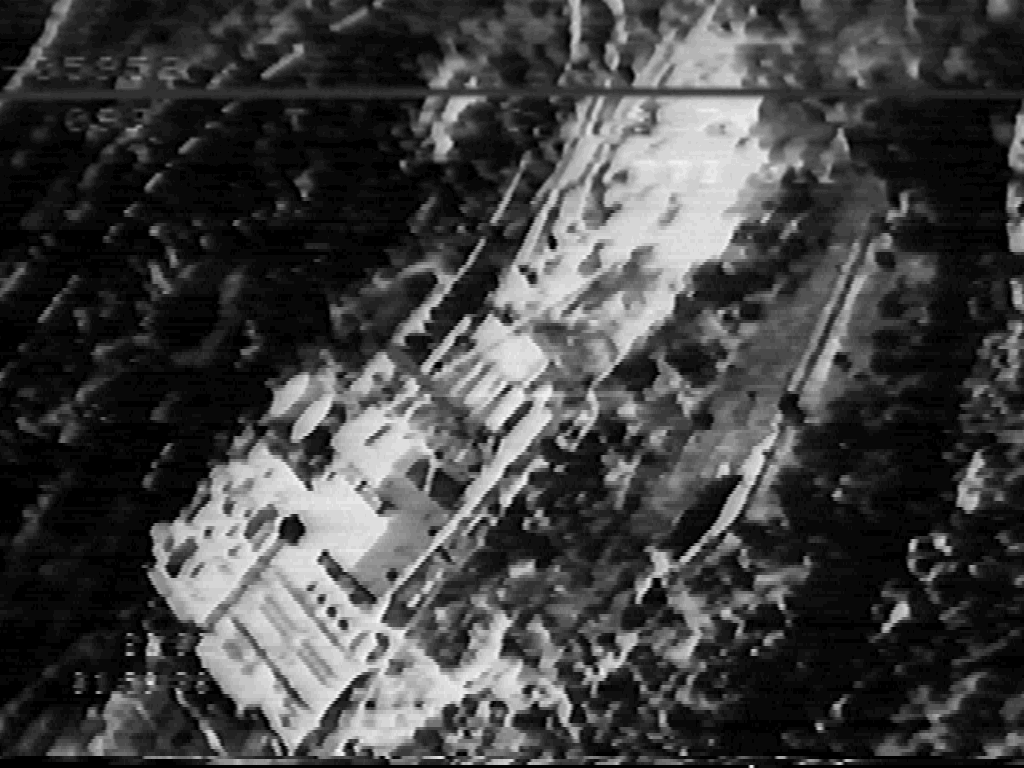 
|
||||
GD F-111C Simulator (RAAF Amberley - 1983) Simulated sortie from
Navigator's
station including autobomb blind radar attack on shipping and bridge
targets using AJQ-20A nav attack and APQ-113 attack radar. Weapons
delivered 4 x Mk.84 LDGP Snake Eye. Read the report. Face stuck to the
scope, orange phospor glowing, a pleasurable
introduction to the trade of the Navigator (or Whizzo in the USAF).
Blind bombing is hard work to do well, and it took plenty of effort to
put the Snakes on target! Two times Delta Hotel, I am happy to say...
(photo Carlo Kopp)
 |
||||
Lockheed-Martin Joint Strike Fighter Simulator (Avalon, 2003) |
||||
 |
||||
The Joint Strike Fighter compares in handling and performance very closely to the F/A-18F - the simulator strongly reflects the design spec requirement to deliver similar handling and performance to the F-16C and F/A-18. The most notable feature of the JSF from a pilot's perspective is the superb 'soft' digital cockpit, where a single projected screen replaces the traditional instrument panel. System and display modes are invoked using either HOTAS controls or by using the touchscreen function on the instrument panel. The demonstration flight lasted close to 45 minutes, during which time I performed vertical takeoffs, landings, hover, a simulated intercept and JDAM drop, and some edge of the envelope manoeuvre - pulling the JSF into the vertical until it departed and recovering the aircraft. A very comfortable aircraft to handle and easy cockpit to operate after a mere 15 minutes of practice, but limited in top end aerodynamic performance as expected. Not quite an F-105D Thunderchief. |
||||
General Aviation Types |
||||
Zlin Z.242L |
||||
 The
Czech Zlin Z.242 is
a former Warpac ab-initio military and aerobatic trainer. Aussie
visitors might note that it is much like a more refined and very
polished
CT-4A. The current export Z.242L is powered by a 200 HP IO360 with a 3
bladed constant speed prop. Side by side seating and stick controls are
standard. This aircraft exhibits control harmonisation and handling
more
typical of larger military trainers, like the PC9/A, but is much slower
and less powerful. The aircraft is by far the nicest GA type I have
flown, and is well suited to intermediate and many advanced competition
manoeuvres. It feels like a real aeroplane.
 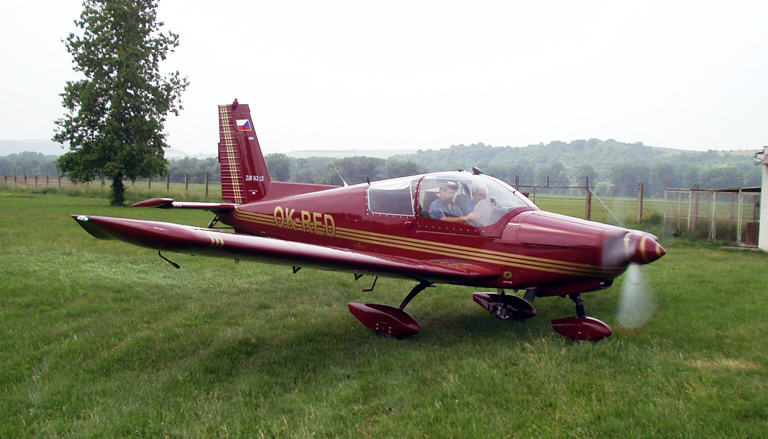   (Manufacturer
Photos)
|
||||
CT-4A Airtrainer / Parrot |
||||
|
I flew an RAAF CT-4A in 1991. The overall
impression is of an aircraft which is very pleasant to aerobat and
requiring little effort to manoeuvre well, any reasonably experienced
aerobatic pilot will find it both easy and comfortable to learn. The
controls are sufficiently sensitive to provide for precise handling
through the manoeuvre, without the poor damping which is characteristic
of some civilian aerobatic trainers. Read the report.
 1 FTS CT-4A Parrot at RAAF Point
Cook in 1991 (┐ 1991 - 2010 Carlo Kopp; M645/1000S).
|
||||
Pitts S-2A |
||||
 I did one hour of dual time in Pitts S-2A
VH-SZA intending to do a type endorsement. The aircraft tragically crashed
a week later, killing a friend and also my former instructor. I was
impressed with the responsiveness and low control damping in the Pitts
S-2A, but the static stability margin was very tight. Landings are
reminiscent of accounts of Bf-109 and Spitfire landings, narrow and
frail undercarriage, and a need to slideslip all the way into the
flare. The S-2 is built for competition work, and type conversion, and
is an excellent performer across the envelope, but also not a forgiving
aircraft. Depicted is VH-UPU, acquired by GFS as an advanced aerobatic
trainer.
|
||||
Bellanca 8KCAB, Moorabbin Airport, 1993 |
||||
 |
||||
| Taxiing
out
for
some
aerobatic
practice at Moorabbin in Decathlon VH-SAR. |
||||
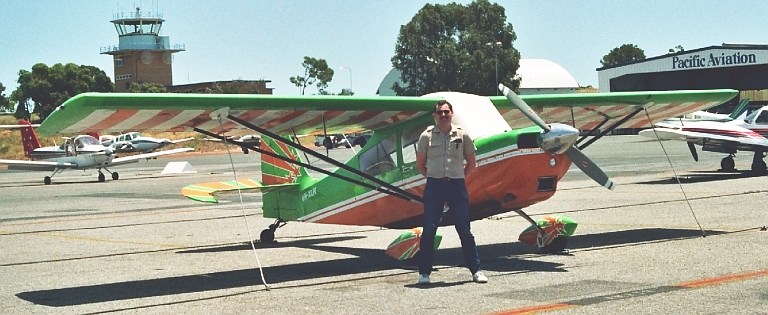 |
||||
| Super
Decathlon
VH-XUK
at
Jandakot
- maintaining aerobatic proficiency
whilst vacationing in Perth. |
||||
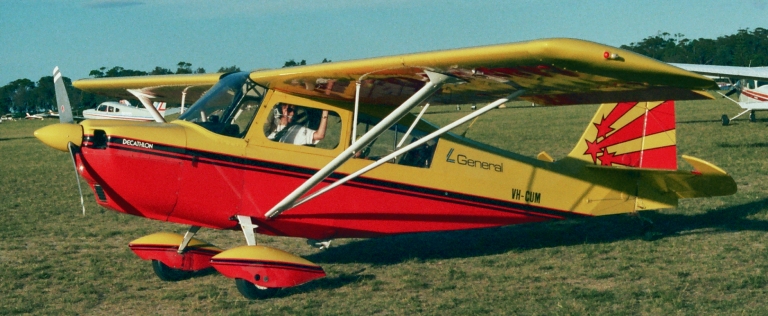 |
||||
| Decathlon
VH-CUM
-
my
favourite
of the two GFS Decathlons at Moorabbin. |
||||
| The
8KCAB is rather underpowered, has a narrow range of useful airspeeds
(ie low Vne) and is thus very demanding of good energy
management in
manoeuvres. You only need to pull half a G beyond the optimum for the
manoeuvre and you will start bleeding energy very quickly. A fun game
to
play were very steep sideslipping final approaches, straightening out
at
the last moment for a flare and touchdown. An easy aeroplane to fly
poorly and a demanding one to fly exceptionally well. |
||||
 |
||||
 |
||||
Piper PA-28 Warriors, Melbourne, 1993 |
||||
 |
||||
| This
pair of Warriors is one arm of a 5-Vic formation, during a
demonstration formation flypast. I have flown many sorties as lead
pilot
for formations of up to 10 aircraft, and under these conditions
achieving the required smoothness in aircraft handling can be quite
demanding, especially with an mediocre handling and underpowered
aircraft like a PA-28, on a hot and bumpy day. Give me a PC-9 or JPATS
any day! |
||||
Piper PA-28R Arrow III/IV, Melbourne, 1990 |
||||
 I did my constant speed prop and retractable
undercarriage endorsements on the Arrow, flying both the conventional
Arrow III and T-tail Arrow IV variants. I was disappointed with the
Arrow, as performance was only marginally better than the Warrior,
despite the retractable gear and constant speed props.
|
||||
Piper PA-44 Seminole, 1990 - 1993 |
||||
 |
||||
All
of my twin training and some portion of my NVFR and IFR training was
flown on the Seminole. The Seminole is fun to fly, although the
increased moment of inertia in roll is quickly felt, compared to a
single of similar mass, often requiring a stab of opposite aileron to
effect a sharp recovery. A nice basic twin trainer and a pleasure to
fly
IFR/NVMC intercepts in.  MFS Seminole in July, 2012. |
||||
DH-82 Tiger Moth, circa 1992 |
||||
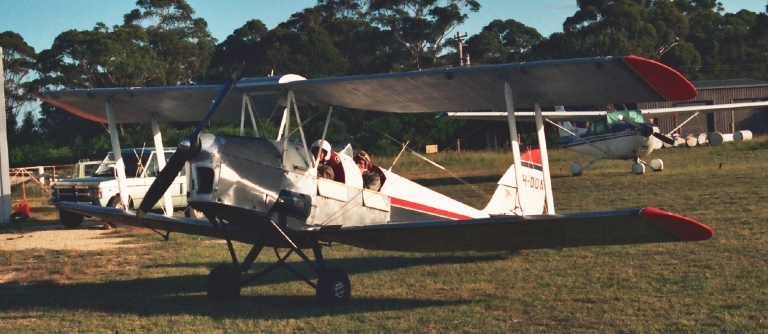 |
||||
|
After hearing so many
extol the
virtues of the Tiger Moth, I was deeply disappointed when I had the
opportunity to actually aerobat one. The Moth is terribly underpowered,
draggy, has poor aileron authority, exacerbated by a large moment of
inertia in roll, and overly sensitive elevator and rudder controls.
Arguably the most poorly harmonised controls in any type I have ever
flown. Spinning the Moth was an interesting challenge in its own right.
Depicted above the aircraft flown. I regard the Moth to be a 'pet hate'.
De Havilland DH-82A Tiger Moth II
in July, 2012 [Click for HD Background]
|
||||
CAC CA-25 Winjeel |
||||
 In 1990 I did about 20 minutes of dual time
in this Winjeel. My first exposure to a military trainer of that
generation. Compared to GA aircraft, a bit like driving a truck.
|
||||
Cessna 172, 1992 |
||||
 Image 2012 |
||||
My
other 'pet hate' in GA types is the Cessna 172. I have never understood
why the 172 was so popular, given its mediocre handling, poor upper
hemisphere visibility and general clumsiness. |
||||
Cessna 150, 1991 |
||||
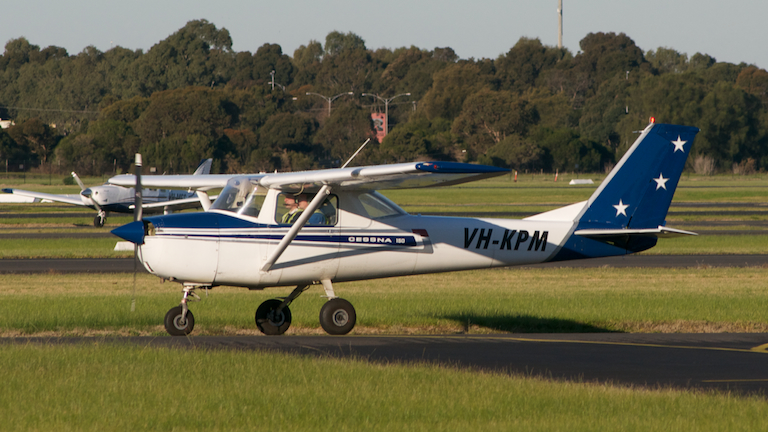 Image 2012 I did one hop in the 150 and having flown
the 8KCAB previously, was decidedly unimpressed with the handling, but
especially lack of power in this basic aerobatic trainer. It loses far
too much altitude in basic manouevres.
|
||||
General
Aviation Imagery (I)
|
||||
|
|||||||||||||
![Sukhoi PAK-FA and Flanker Index Page [Click for more ...]](APA/flanker.png) |
![F-35 Joint Strike Fighter Index Page [Click for more ...]](APA/jsf.png) |
![Weapons Technology Index Page [Click for more ...]](APA/weps.png) |
![News and Media Related Material Index Page [Click for more ...]](APA/media.png) |
||||||||||
![Surface to Air Missile Systems / Integrated Air Defence Systems Index Page [Click for more ...]](APA/sams-iads.png) |
![Ballistic Missiles and Missile Defence Page [Click for more ...]](APA/msls-bmd.png) |
![Air Power and National Military Strategy Index Page [Click for more ...]](APA/strategy.png) |
![Military Aviation Historical Topics Index Page [Click for more ...]](APA/history.png)
|
![Information Warfare / Operations and Electronic Warfare Index Page [Click for more ...]](APA/iw.png) |
![Systems and Basic Technology Index Page [Click for more ...]](APA/technology.png) |
![Related Links Index Page [Click for more ...]](APA/links.png) |
|||||||
![Homepage of Australia's First Online Journal Covering Air Power Issues (ISSN 1832-2433) [Click for more ...]](APA/apa-analyses.png) |
|||||||||||||
| Artwork, graphic design, layout and text © 2004 - 2014 Carlo Kopp; Text © 2004 - 2014 Peter Goon; All rights reserved. Recommended browsers. Contact webmaster. Site navigation hints. Current hot topics. | |||||||||||||
|
Site Update
Status:
$Revision: 1.753 $
Site History: Notices
and
Updates / NLA Pandora Archive
|
|||||||||||||
|
|
Tweet | Follow @APA_Updates | |||||||||||
|
|
|||||||||||||
|
|
|||||||||||||